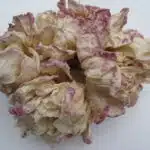Have you ever been in awe of a rose bush that seemed to grow up into the clouds and create an impenetrable wall of soft, delicate blooms? If so, you are not alone—roses have been beloved by gardeners for centuries! Now, with miniature roses, you can bring this beauty into even the smallest spaces. These little roses are practically bursting with vibrant color and sweet fragrance, yet so tiny that they could fit in the palm of your hand. Miniature roses require special care to ensure they bloom throughout the year but once you know how to care for them properly, they will reward you with joy and beauty like no other flower can.
This article will provide a comprehensive guide on caring for miniature roses so that you can experience the delight of having these beautiful plants in your own home or garden. We’ll cover all aspects of growing miniature roses including soil requirements, planting instructions, watering practices, pruning techniques and more. With this guide in hand, you will be ready to plant some of these enchanting little roses and watch as their vibrant blooms fill your space with pure joy!
Whether you want to start a mini rose garden or just add a few colorful blooms here and there, our guide on miniature rose care will give you all the information necessary to get started on your gardening journey today! Get ready for an amazing adventure filled with fragrant blooms and happy memories—let’s begin!
What Are Miniature Roses?
Miniature roses have become a popular addition to gardens around the world, adding color and beauty to any outdoor space. But what exactly are miniature roses? They are a type of rose that is bred specifically to be smaller in size than their traditional counterparts. This means they can fit into any garden design and require less maintenance than other rose varieties.
Miniature roses are available in a variety of colors, from light pink to deep red and even white. Many also feature beautiful double blooms, appearing like two flowers instead of one. These charming little plants can add an extra touch of whimsy to any landscape, making them ideal for those looking for something special in their garden.
When it comes to care and growing requirements, miniature roses tend to be quite easygoing. They prefer bright sunlight but will tolerate some shade as well. Watering should be done deeply about once or twice a week, depending on your climate and the amount of sun exposure the plant receives. With regular pruning, miniature roses will stay healthy and bloom throughout spring and summer months.
So if you’re looking to add some charm to your garden without too much fuss or effort, consider adding some miniature roses! You won’t regret it!
Choosing The Right Miniature Rose Plant
Coincidentally, choosing the right miniature rose plant is a crucial step in cultivating these beautiful plants. Not only are there plenty of varieties to pick from, but each type has its own unique needs and preferences. To help you choose the perfect miniature rose for your garden, here are four tips:
Know your climate: Some miniature roses can thrive in colder climates while others need more warmth. Research which types of roses will do well in your area before making a purchase.
Get the size you want: Miniature roses come in different sizes and shapes that range from small bushes to climbing vines. Consider how much space you have available and what aesthetic you’re going for when selecting a variety for your garden.
Select disease-resistant varieties: Not all roses are created equal when it comes to disease resistance. Look for cultivars that are resistant to common diseases like rust, black spot, and mildew so that they’ll stay healthy through the growing season.
Choose low-maintenance plants: Some varieties require regular pruning or special fertilizers to stay healthy, while others are more low-maintenance and can be planted with minimal care and upkeep. Decide which is best suited for your lifestyle before making a selection.
Taking the time to select the right miniature rose for your garden will pay off in the long run! With these tips in mind, you’ll be able to find a variety that fits perfectly into your landscape and provides years of beauty—all without having to put forth extra effort or expense on maintenance tasks like pruning or fertilizing. It’s now time to get started on planting those miniature roses!
Planting Miniature Roses
Planting miniature roses is like planting a bouquet of sunshine in your garden. It’s a joyous, fragrant experience that will bring much delight to you and your visitors. Here are four tips for planting miniature roses:
Choose an area with well-draining soil that receives plenty of sunlight. Miniature roses thrive in direct sunlight for about 8 hours per day, so make sure the area you plant them has access to this kind of sun exposure.
Dig a hole twice as wide and twice as deep as the root ball of your rose bush. This will give the roots plenty of room to spread out and start growing.
Add some organic matter to the soil such as compost or aged manure before planting your miniature rose bush. This will help improve the fertility and water retention capacity of the soil around it.
Plant your miniature rose bush at the same depth it was planted in its container and then fill in with more soil until it is completely covered. Water thoroughly after planting, making sure the entire root ball is moistened but not soggy.
By following these steps, you can ensure that your miniature roses have everything they need to get established and start producing beautiful blooms for many years to come. Now that you have planted your miniature roses, it’s time to learn about their specific sunlight requirements for optimal growth and flowering potential.
Sunlight Requirements For Miniature Roses
It’s a coincidence that miniature roses, such as their larger counterparts, have a specific requirement for sunlight – they need at least 6 hours of direct sun each day. This is particularly important when it comes to growing and caring for these delicate flowers. After all, without the right amount of sun exposure, plants may not bloom or produce healthy foliage.
So, what should you do to ensure your miniature roses get enough sunlight? First, you’ll want to select an area of your garden that receives full sun throughout the day. If possible, try to avoid areas with heavy shade or an abundance of trees or tall shrubs, as this can create too much shade for your roses and prevent them from getting enough sunlight. Additionally, if you’re keeping your miniature roses in containers indoors or on a balcony or patio, make sure there is ample sunlight exposure and that the container is placed in an area where it won’t be shaded by other objects.
Once you’ve found the ideal spot for your roses and you’re sure they’re getting plenty of light each day, it’s important to monitor their growth closely. Check daily for signs of wilting or yellowing leaves; these are telltale signs that your roses are not receiving enough sun exposure. If necessary, adjust their location so they get more direct sunlight in order to help them thrive.
Soil Requirements For Miniature Roses
Soil is an essential element when it comes to growing miniature roses. It provides the roots with the nutrition and stability they need to thrive. Like a tapestry of colors and textures, soil can make all the difference between a successful harvest and one that fails.
It’s important to remember that miniature roses require well-drained soil, rich in organic matter. The ideal combination is three parts loam, two parts peat, and one part coarse sand or perlite for good drainage. Compost can be added for extra nutrients too, but should not exceed more than 10-15% of the total mixture.
In addition to providing nutrients, the soil should also be slightly acidic (pH 6-6.5) to help keep diseases away from these delicate plants. Checking with a local garden center or nursery for specific recommendations is always best practice. With the right soil conditions in place, miniature roses are sure to produce beautiful blooms year after year!
Watering them correctly will ensure they get off to a strong start and continue to thrive in their new environment.
Watering Miniature Roses
Watering miniature roses is like providing a nourishing, life-sustaining drink to a weary traveler. It’s an act of service and love, helping these delicate flowers to reach their full potential. To achieve this goal, here are some essential steps:
• Water at soil level instead of pouring directly onto the leaves – this will help prevent fungus and other moisture-related diseases. • Allow the water to penetrate deeply into the soil to reach all the way down to the roots. • Be sure not to overwater – too much can lead to root rot or cause the leaves to droop and discolor.
Just as with humans, it’s better for miniature roses to have a few small sips of water more frequently than one large gulp every so often. This will keep them hydrated without drowning them in too much liquid. Additionally, check the soil before adding water – if it’s still moist from the last watering session, wait until it has dried out before providing another drink.
Keeping miniature roses properly hydrated is vital for their health and growth. With proper care and attention, these beautiful plants can bring joy for years to come!
Fertilizing Miniature Roses
How do you ensure that your miniature roses get the nourishment they need to thrive? Fertilizing is an essential step in caring for your miniature roses. But what type of fertilizer should you use, and when should you apply it? Let’s explore these questions more closely.
Like most other flowering plants, miniature roses require a balanced fertilizer with equal parts of nitrogen, phosphorus, and potassium (N-P-K). An ideal fertilizer will contain 10-10-10 or 12-12-12 N-P-K. It’s usually best to fertilize your miniature roses during spring and fall when new growth is starting. However, you may want to fertilize more often if the plant isn’t growing well or is losing its color.
When applying fertilizer, be sure not to overdo it. Too much can burn the roots and kill the plant. Instead, start off with small amounts of fertilizer and gradually increase as needed. If you’re unsure how much to apply, it’s a good idea to consult a professional or read up on proper fertilization techniques online.
TIP: When fertilizing your miniature roses, use an all-purpose formula with equal parts nitrogen (N), phosphorus (P), and potassium (K). Start off with small amounts of fertilizer and gradually increase as needed – too much can burn the roots and harm the plant!
Pruning Miniature Roses
The theory that pruning can be beneficial for miniature roses has been around for a long time. It is true that proper pruning of your miniature roses throughout their life cycle can help them grow healthy and strong, while also producing beautiful blooms. Here are three key points to keep in mind when it comes to pruning miniature roses:
- Prune dead wood away from the plant during the winter months, as this will help encourage new growth in the spring.
- Trim back branches that are crossing each other or rubbing against each other in order to promote good air circulation, which will help prevent disease.
- In late summer, you should give your miniature roses a light trim to remove any spent blooms and encourage more flower production for the next season.
When done correctly, pruning provides numerous benefits for your miniature rose plants. Not only does it keep them looking neat and tidy, but it also helps ensure healthy growth and lots of beautiful flowers year after year! Moving forward, we’ll look at some common pests and diseases of miniature roses so you can better protect your plants from harm.
Common Pests And Diseases Of Miniature Roses
Like a fortress wall, pests and diseases can encroach on miniature roses if not taken care of. As such, it’s important to be vigilant while growing these delicate buds. From fungal infections to insect infestations, there are several issues that can arise when caring for miniature roses.
Fungal diseases like powdery mildew, rust, and black spot can cause discoloration and wilting of the leaves and stems of the rose bush. In order to prevent fungal diseases from forming, it’s important to provide adequate air circulation around the plant by pruning and avoiding overhead watering. Additionally, applying fungicides when necessary may help prevent further spread.
Insects can also be a problem for miniature roses; aphids, spider mites, thrips, and Japanese beetles are among some of the most common pests found on them. To keep these insects away from your plants, use insecticidal sprays or soaps as needed. Additionally, you can place sticky traps or introduce beneficial insects like ladybugs into your garden to help reduce insect populations naturally.
Transplanting is a critical aspect of proper miniature rose care in order to ensure long-term growth and health of the plant. Taking into account factors like soil quality and light exposure will ensure a successful transplant process.
Transplanting Miniature Roses
Transplanting miniature roses is an important step in gardening, as it allows you to move the plants around your space and give them new life. Transplanting can help roses thrive in a new environment, or even save them from certain death if they’re not doing well in their current spot. To ensure a successful transplant, it’s best to understand the correct techniques and timing.
When transplanting miniature roses, the most important thing to remember is that you shouldn’t do so during the heat of summer or when temperatures dip below freezing. Instead, wait until early spring or late fall for optimal results. Once you’ve selected a good time to transplant, make sure the soil is moist and free of debris before taking out your rose bush. Then carefully dig around the roots of the rose bush and attempt to keep them intact while lifting it out of the ground.
When placing your miniature rose into its new home, be sure to dig a hole twice as wide as its root ball but just deep enough so that its previous soil line is level with that of its new area. After setting your plant in its hole, backfill with soil and water until fully saturated before adding mulch around it for insulation. With proper care and attention during this process, you’ll be able to successfully transplant your miniature rose bush into its new home!
Propagating Miniature Roses
Propagating miniature roses can be a rewarding exercise, one that will bring additional joy to your gardening experience. It’s like striking gold in the soil! With the right preparation and knowledge, anyone can successfully propagate these delicate flowers.
To get started, collect some healthy cuttings from an existing bush and remove any leaves from the lower portion of the stems. Place them in water or moist potting soil and keep in a warm location with bright, indirect sunlight. In order to encourage root growth, you may want to consider using a rooting hormone to help speed things up.
Once your cuttings have taken root and established themselves, you can then transplant them into individual pots or beds. Make sure they are planted at least 6-8 inches apart so they have enough room to properly grow and flourish. Provide plenty of water during the first few weeks after planting and keep an eye on them for signs of disease or pests as they transition into their new environment.
With some patience, care, and attention you will soon have a garden full of beautiful miniature roses!
Staking Miniature Roses
Staking miniature roses is a surprisingly easy task that can have an overwhelmingly positive impact on their growth and beauty! It’s almost magical how quickly they become vibrant, lush plants with some simple support.
Supporting young roses is especially important since they are unable to stand up to the elements without it. A good staking job helps the plant handle wind and rain, as well as heavy blooms. Even mature roses benefit from proper staking; it prevents branches from breaking off due to heavy winds or over-burdening of flowers.
The most important thing to remember when staking miniature roses is not to use something too thick or stiff. The goal is to provide a gentle support rather than a rigid one. Use wooden or bamboo stakes and secure them in place with string or twine for stability. This will also ensure that your rose bush has enough space for its roots to spread out and grow properly.
By taking the time to properly stake miniature roses, gardeners can give these delicate plants the support they need to thrive in any environment. With this extra help, these lovely little blooms can live up to their full potential!
Winter Care Of Miniature Roses
Coincidentally, winter care of miniature roses is an important step in ensuring these delicate flowers thrive and look their best. After all, these beautiful blooms bring joy to any garden or display with their bright colors and captivating fragrances. Taking the time to provide the necessary winter care for miniature roses will ensure they come back healthy and strong each spring.
For starters, it’s important to mulch around the base of your miniature rose bush in late fall for insulation against cold temperatures. This helps protect the root system from extreme temperatures by providing a buffer between the soil and outer environment. Additionally, make sure to water deeply throughout the season and especially during dry periods of winter weather. This will help keep your roses hydrated through the colder months when there’s less rainfall.
Lastly, prune away any dead or damaged canes as soon as possible since leaving them on can encourage disease and weaken the overall health of your plant. Also, don’t forget to clean up fallen leaves around the roses since they can also harbor fungal diseases that could harm your plants! With these steps in place, you’ll be well on your way to having healthy miniature roses year after year. Ready for more? Let’s now explore displaying these colorful beauties for maximum impact!
Displaying Miniature Roses
Once upon a time, displaying miniature roses was a privilege reserved only for the wealthy. Nowadays, this gorgeous flower is accessible to everyone – and what better way to spruce up your garden than with these colorful blooms? Here’s a guide on how to show off your miniature roses in style:
Container Gardening: Container gardening is an ideal way to show off miniature roses without having them take over your entire yard. This type of gardening also allows you to move the flowers around as you please and gives you more control over the environment they’re planted in.
Plant Pots: Plant pots are a classic choice for displaying miniature roses. You can get creative by painting them or adding decorations – like ribbons or stones – for an extra personal touch. Plus, the portability of plant pots makes it easy to move your flowers if need be!
Wall Planters: Wall planters provide an eye-catching way to display miniature roses while saving valuable space in your garden or home. These planters can be hung up on walls or fences, allowing you to add beauty and color to any wall with minimal effort.
No matter which option you choose, displaying miniature roses is sure to brighten up any place and make it look more inviting. With just a little bit of love and care, these beautiful blooms will be sure to bring joy wherever they go!
Tips For Growing Miniature Roses
Beautifying your home and garden with miniature roses is an enriching experience. With the right care, these small blooms can spread beauty across your home in a variety of shapes and colors. Here are some essential tips for growing miniature roses to make sure you get the most out of them.
Firstly, it’s important to find a spot for your miniature roses that gets plenty of sun. You’ll want six to eight hours of direct sunlight each day, as well as protection from harsh wind. Here’s how to ensure your roses thrive:
Provide enough water and fertilizer – Use liquid fertilizer every two weeks during the growing season to keep your miniature roses healthy. Water frequently so that the soil stays moist, but not soggy.
Deadhead regularly – Removing dead flowers will help maintain a full bloom throughout the season. This will also encourage more flowers and reduce disease issues that can occur in wet climates.
Prune often – Pruning minimizes disease problems and encourages new buds to form on old canes. It also helps maintain shape and size, which is especially important with such small plants!
Growing mini roses doesn’t have to be intimidating; with proper care they can bring joy into any space! As long as you provide plenty of light, water, fertilization, pruning, and deadheading–your mini roses will be sure to flourish!
Frequently Asked Questions
How Much Space Do I Need To Grow Miniature Roses?
Growing miniature roses can be a rewarding experience for any gardener. As the name implies, these roses are smaller than traditional varieties, making them easier to care for and perfect for planting in urban or suburban areas. But how much space do you need to grow miniature roses?
Let’s start with an anecdote. I recently visited my neighbor’s garden and was surprised to find that she had planted dozens of beautiful miniature roses in her small backyard! She told me that she had researched how much space she needed before planting and determined that each plant required at least two feet of space between them. Her careful planning paid off as her garden was full of bloom!
When it comes to growing miniature roses, there are a few factors to consider before you decide how much space is necessary. Here’s a 4-item list outlining what you should keep in mind:
- The type of rose – some varieties are more compact than others, so check the specifics of your chosen variety before deciding on spacing;
- The climate you live in – this affects the size and shape of each plant;
- Whether or not you’re pruning – regular pruning will help keep your plants healthy but also reduce their size;
- Your desired effect – if you’re looking for a dense hedge or border, then closer spacing would be advantageous.
By taking all of these things into consideration, you’ll have no problem finding the right amount of space for your miniature roses to thrive! With the right care and attention, these beautiful blooms will add color and life to any outdoor area – whether it be a large garden or a small balcony – allowing you to enjoy nature at its best every day.
How Do I Know When To Water My Miniature Roses?
Did you know that miniature roses are one of the most popular flowers to grow in gardens across the world? If so, you may be wondering how often to water your miniature roses. Knowing when and how much to water your plants is essential for their health and wellbeing.
The amount of water your miniature roses need will depend on several factors, including the type of soil, weather conditions, and the size and age of your plant. As a general rule, it’s best to keep the soil around your roses damp but not wet. If it looks dry then give them a good soaking or sprinkle them with a hose until they’re moistened through. You should also check if the leaves look wilted – this can be a sign that they need more water. Additionally, take into account that they may need more frequent watering during hot summer months than in cooler seasons.
If you’re still having trouble determining when to water your miniature roses, try sticking your finger about two inches into the soil near the base of each plant; if it feels dry then give them some H2O! Or alternatively, invest in a moisture meter which will tell you exactly when to water them. With proper care and attention, growing healthy miniature roses doesn’t have to be difficult! Just remember: keep an eye on weather conditions and use your finger or moisture meter as guides for when to give them a drink.
What Type Of Pot Is Best For Miniature Roses?
When growing miniature roses, having the right pot is essential for success. The right pot can help ensure that your roses have the right amount of drainage and soil nutrients to thrive. But how do you determine which kind of pot is ideal for miniature roses?
The first factor to consider when selecting a pot for miniature roses is size. Miniature roses need plenty of room to grow, so a larger pot is usually best. Most experts recommend choosing a container that’s at least 10 inches deep and 8-10 inches wide. A container that’s too small won’t give the roots enough space to expand, leading to stunted growth. Furthermore, a container that’s too large may cause excessive root growth and reduced flowering.
Another important factor when selecting a pot for miniature roses is material. Usually ceramic pots or plastic containers are ideal because they retain moisture better than terracotta or wood pots. Additionally, plastic containers are lightweight and easy to move around in case you want to change the location of your miniature rose bush. Whichever type of container you choose, make sure it has plenty of drainage holes at the bottom so that excess water can escape without causing root rot or other damage.
With these tips in mind, you’ll be able to select the perfect pot for your miniature rose bush with confidence! Remember to take size and material into account as you shop around—this will make it easier to find the perfect home for your beloved mini rose plants!
How Often Should I Fertilize My Miniature Roses?
Fertilizing a miniature rose is like giving it a vitamin boost – it helps keep the petite flower healthy and blooming. When you give your roses the right amount of fertilizer, you can keep them looking beautiful for years. So how often should you fertilize your miniature roses?
If you want your miniature roses to thrive, regular fertilization is essential. Depending on where you live and the type of soil in your garden, your roses may need to be fertilized every four to six weeks during the growing season. During this time, use a balanced fertilizer that contains nitrogen, phosphorous, and potassium to ensure that all of the plant’s needs are being met. If you’re unsure about what type of fertilizer to use or how much to apply, consult with a local gardening center or experienced grower for advice.
When feeding your miniature roses, it’s important not to overdo it; too much fertilizer can cause burning or other damage to the delicate petals. Always follow package instructions when applying fertilizer and water thoroughly afterwards. If you’re concerned about keeping track of when they were last fed, consider using stakes with flags marked with the application date – this will help remind you when it’s time for their next meal!
By providing regular feedings throughout the season and following proper application instructions, you can help ensure that your miniature roses stay happy and healthy for years to come.
Are Miniature Roses Drought Tolerant?
Miniature roses, with their delicate petals and vibrant colours, add a beautiful touch to any garden. But before you can enjoy their beauty, you may be wondering if they are drought tolerant? The answer is yes – with the right care and attention, miniature roses can thrive in even the driest of climates.
To ensure your miniature roses survive in harsh weather conditions, there are few key steps you should take:
• Keep them well-watered – water your miniature roses regularly so that the soil around them stays moist (but not soggy). • Mulch them – mulch provides insulation for the roots of your miniature roses which helps keep the soil at an optimal temperature. • Plant them in raised beds or containers – this will help keep their roots from becoming too dry and it also makes watering easier. • Protect them from extreme temperatures – this means keeping them out of direct sunlight during hot days and protecting them from frost during cold nights. • Prune regularly – pruning helps maintain the shape of your miniature roses as well as promote healthy growth.
With these tips in mind, you can feel confident that your miniature roses will survive even the most extreme weather conditions! With a bit of extra care and attention, you can enjoy the beauty of these special plants all year round. With a little bit of effort, your garden will be filled with lush greenery and colourful blooms no matter what Mother Nature throws its way!
Conclusion
The miniature rose is a beautiful and rewarding plant to add to any garden or living space. With proper care and attention, these delicate flowers will reward you with their vibrant blooms year after year. Growing miniature roses may seem intimidating at first, but with just a few simple steps, you can ensure your plants will thrive. Knowing when and how much to water your miniature roses, what kind of pot they need, and how often they should be fertilized are all important things to consider.
These miniature roses may be small in stature, but they are mighty in beauty! With the right environment and care, you can create an oasis of color that will bring life to any area of your home. Plus, these little beauties are quite resilient and drought tolerant too!
So don’t be shy – let those rose petals bloom! With the right tools and knowledge, anyone can create a stunning display of miniature roses that will fill your heart with joy for years to come.





























